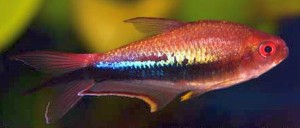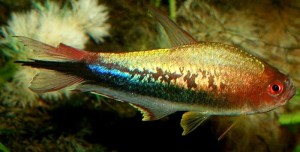The Rainbow Tetra (Nematobrycon lacortei) is peaceful shoaling species that is found in sluggish tributaries, small quiet rivers (Río Calima) and streams of the Rio San Juan basin in western Colombia, S.A.
The Rainbow Tetra (Nematobrycon lacortei) is rarer and the more colorful of the two species of Emperor Tetras that are found in Colombia.
Although Rainbow Tetras (Nematobrycon lacortei) share many of the same traits as the Emperor Tetra (Nematobrycon palmeri), other characteristics readily distinguish the species from each other.
Both species have club shaped bodies, a dark stripe that extends from the eye to the caudal fin, a trident tailed caudal fin with a central spike, and long anal fins that extend from the vent of the fish to the caudal fin.
They differ in that the male Emperor Tetra has a sickle shaped dorsal fin. The dorsal fin in the Rainbow Tetra is more triangular shaped and shorter. The Rainbow Tetra’s body color literally has every color of the rainbow displayed, while the Emperor Tetra is usually green or blue towards the front of the body, and a brownish gold over the balance.
The Rainbow Tetra’s eyes are large and banded with red, whereas the Emperor Tetra’s eyes are also large but blue in color. The males of both species have long flowing dorsal fins that end in a point, but the dorsal fins of female Rainbow Tetras are more triangular shaped.
Rainbow Tetras are peaceful but somewhat territorial towards each other and should be kept together in groups of at least 10 or more of their own kind to minimize aggression between rival males.
They can be housed in a peaceful South American community tank with Nematobrycon lacortei and other tetras, Angelfish, gourami, rasboras, danios, dwarf South American cichlids, small catfish and loaches.
They also do well with Hemigrammus or Hyphessobrycon species, Apistogramma, Anabantoids and West African dwarf cichlids such as Pelvicachromis.
Rainbow Tetras do best in a densely planted, dimly lit 20 gallon (or larger) tank, with a dark fine gravel or sandy substrate, some driftwood or bogwood roots, and some river rock. Adding some floating plants
will help mimic their natural habitat, provide additional cover, and bring out the rainbow hues of these beautiful fish.
Rainbow Tetras are rarely seen in the aquarium hobby today and breeding them is somewhat difficult. The females lay only one egg at a time and like many characins, will eat their eggs when given a chance. The fry are extremely light sensitive and seldom survive unless they are kept in an aged, densely planted tank of fine leaved plants.
When breeding Rainbow Tetras, place a group in a large well planted tank with slightly acidic water and no other fish. When conditioned on a diet of live or frozen foods, no extra stimulation is usually needed to get a pair to spawn and a majority of the fry will survive in the tank if the parents are removed immediately after spawning.
In an established, densely planted aquarium, the fry will have enough algae, protozoa, infusoria, etc. to survive. As they grow, they can be fed Daphnia and crushed dry flake food.
Adult Rainbow Tetras are omnivores and will readily eat fresh, frozen, or freeze dried brine shrimp, daphnia, bloodworms, tubifex, micro pellets and high quality flake foods.
Rainbow Tetras are uncommon and when available for sale are usually wild caught specimens at a size of 3/4″ to 1 1/4″.
Minimum Tank Size: 20 gallons
Care Level: Moderate
Temperament: Peaceful
Water Conditions: 73-80° F, 1 to 12°H, pH 5.6 – 7.2
Max. Size: 3/4”
Color Form: Black, Purple, Silver
Diet: Omnivore
Compatibility: Peaceful community tanks
Origin: San Juan basin in western Colombia, South America
Family: Characidae
Lifespan: 4-6 years
Aquarist Experience Level: Experienced




